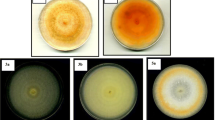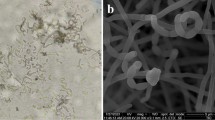Abstract
The conidia produced by the mycelial form of Paracoccidioides brasiliensis were examined by scanning electron microscopy for the first time. Several different conidial types were characterized. These included intercalary arthroconidia, several types of septate conidia that are formed from other conidia, pedunculate conidia, and terminal hyphal conidia. In addition, the ultrastructure of the supporting pedestal of the pedunculate conidium was found to be separated from the mother conidium by a septum in some instances, and at other times it was not.
Similar content being viewed by others
References
Borelli D. Les aleurias de P. brasiliensis. Mem VI Cong Venezo Cien Med 1955; 4: 2241–53.
Bustamante-Simon B, McEwen JG, Tabares AM, Arango MA, Restrepo-Moreno A. Characteristics of the conidia produced by the mycelial of Paracoccidioides brasiliensis. Sab: J Med Vet Pathol 1985; 23: 407–14.
Conant NF, Howell A. The similarity of the fungi causing South American Blastomycosis (Paracoccidioides granuloma) and North American Blastomycosis (Gilchrist Disease). J Invest Derm 1942; 5: 535–370.
Franco M, Sano A, Kera K, Nishimura K, Takeo K, Miyaji M. Chlamydospore formation by P. brasiliensis mycelial form. Rev Inst Med Trop Sao Paulo 1989; 32: 151–7.
McEwen JG, Bedoya V, Patiño MM, Salazar ME, Restrepo A. Experimental murine paracoccidioidomycosis induced by the inhalation of conidia. J Med Vet Mycol 1987; 25: 165–75.
McGinnis MR. Laboratory handbook of medial mycology. Glossary. Academic Press, New York, 1980; p. 590.
Neves AJ, Bogliolo. Researches on the etiological agents of the American Blastomycosis. Mycopath Mycolog Appl 1951; 5: 132–42.
Pollak L. Aleuriospores of P. brasiliensis. Mycopath Myclog Appl 1971; 45: 217–9.
Restrepo A. A reappraisal of the microscopical appearance of the mycelial phase of P. brasiliensis. Sab 1970; 8: 141–4.
Restrepo A, McEwen JG, Salazar ME. The mycelial form of P. brasiliensis. In: Proceedings X Congress Internat Soc Human and Animal Mycology (ISHAM). Torres-Rodriguez, JM (ed), JR Prous Science, Barcelona, Spain, 1988; pp. 143–8.
Rippon JW. The Pathogenic fungi and pathogenic actinomycetes. Chapter 19, Paracoccidioidomycosis. 3rd. ed. WB Saunders, Philadelphia. 1988; P. 572.
San Blas F. Ultrastructural of spore formation in P. brasiliensis. J Med Vet Mycol 1986; 24: 203–10.
Author information
Authors and Affiliations
Rights and permissions
About this article
Cite this article
Samsonoff, W.A., Salazar, M.E., McKee, M.L. et al. Scanning electron microscopy of the conidia produced by the mycelial form of Paracoccidioides brasiliensis . Mycopathologia 114, 9–15 (1991). https://doi.org/10.1007/BF00436685
Received:
Accepted:
Issue Date:
DOI: https://doi.org/10.1007/BF00436685




